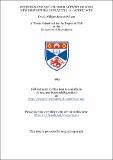Files in this item
Synthesis and anti-tumour activity of some new derivatives of flavone-8-acetic acid
Item metadata
| dc.contributor.author | Wilson, David William Joseph | |
| dc.coverage.spatial | 187 p. | en_US |
| dc.date.accessioned | 2018-07-17T09:15:37Z | |
| dc.date.available | 2018-07-17T09:15:37Z | |
| dc.date.issued | 1995 | |
| dc.identifier.uri | https://hdl.handle.net/10023/15461 | |
| dc.description.abstract | A robust six-step synthesis of substituted flavone-8-acetic acid sodium salts has been developed and optimised to allow preparation of a wide variety of products for testing as anti-tumour agents. The condensation and cyclisation steps have been combined in an efficient one-pot procedure and efficient procedures for subsequent oxidative cleavage of an allyl group and salt formation have been developed. Using this method a total of 18 derivatives bearing substituents on the 2-phenyl ring have been prepared. Based on encouraging activity from methoxy substituted compounds, attention has been concentrated on these and various mono-, di-, tri- and tetramethoxy compounds have been prepared, most for the first time. Activity of these against MAC15A, both in vitro and in vivo has been determined by collaborators at Bradford and several compounds have comparable or greater activity than the unsubstituted prototype. The presence of a 2'-methoxyl substituent appears to be particularly favourable to activity. Five different heterocyclic analogues with furyl, thienyl and benzothienyl groups at the 2-position have been obtained and these also show good activity with the 3-methyl-2-thienyl compound showing the highest in vivo activity of any compound examined. Attempts to prepare pyridyl and quinolyl derivatives were unsuccessful. The 2-benzyl and 2-diphenylmethyl compounds have also been prepared and while the former shows good activity in vitro, it is inactive in vivo probably due to metabolic breakdown. The latter compound is completely inactive probably due to a requirement for planarity in the 2- substituent. An extended derivative has been obtained by an unexpected mode of reaction encountered in an attempt to prepare the 2-phenylethynyl compound. Both this and a dimeric ether analogue show significant activity, thereby adding to our understanding of the structural requirements for activity. Variation in the 8-acetic acid substituted has been examined by synthesis of three compounds with CH₂C(O)CH₂OH at this position and, by a separate multi-stage synthesis, the compound with tetrazolylmethyl. The former compounds are too insoluble for activity to be measured, while the latter is inactive. A comparison of electron density, as reflected by ¹H and ¹³C NMR shifts, against activity in vitro has been made for all the compounds prepared, and while some trends may be discerned, the correlation is generally poor. A suitable single crystal of flavone acetic acid was prepared and its X-ray structure was obtained by the SERC Crystallography Unit, Cardiff. The structure, which proved to be of the monohydrate showed the preferred orientation of the 2- and 8-substituents and provided accurate dimensions for future theoretical work. | en_US |
| dc.language.iso | en | en_US |
| dc.publisher | University of St Andrews | |
| dc.subject.lcc | QD480.A3W5 | |
| dc.title | Synthesis and anti-tumour activity of some new derivatives of flavone-8-acetic acid | en_US |
| dc.type | Thesis | en_US |
| dc.contributor.sponsor | Association of International Cancer Research | en_US |
| dc.type.qualificationlevel | Doctoral | en_US |
| dc.type.qualificationname | PhD Doctor of Philosophy | en_US |
| dc.publisher.institution | The University of St Andrews | en_US |
This item appears in the following Collection(s)
Items in the St Andrews Research Repository are protected by copyright, with all rights reserved, unless otherwise indicated.

